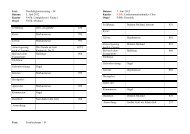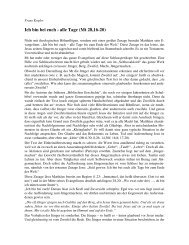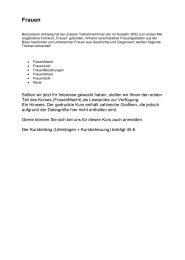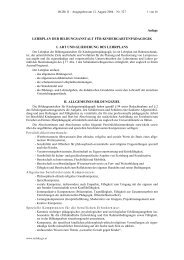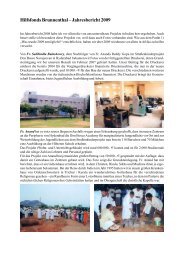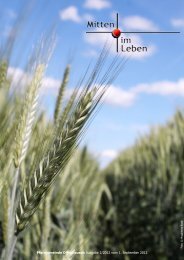The State of Food and Agriculture - FAO
The State of Food and Agriculture - FAO
The State of Food and Agriculture - FAO
You also want an ePaper? Increase the reach of your titles
YUMPU automatically turns print PDFs into web optimized ePapers that Google loves.
24<br />
THE STATE OF FOOD AND AGRICULTURE 2006<br />
BOX 5<br />
<strong>Food</strong> insecurity in crisis contexts<br />
Crisis contexts <strong>of</strong>fer particular challenges<br />
in the design <strong>and</strong> implementation <strong>of</strong><br />
food security interventions. Interventions<br />
need to be based on an underst<strong>and</strong>ing <strong>of</strong><br />
specific crisis contexts <strong>and</strong> the underlying<br />
processes that threaten food security.<br />
A “food security crisis” can be seen as<br />
a time <strong>of</strong> extreme food insecurity, when<br />
the main danger is widespread loss <strong>of</strong><br />
access to food, perhaps leading to famine.<br />
Walker (1989, p. 66) defines famine in<br />
terms <strong>of</strong> “a socio-economic process which<br />
causes the accelerated destitution <strong>of</strong> the<br />
most vulnerable ... to a point where they<br />
can no longer maintain a sustainable<br />
livelihood”. This definition highlights the<br />
close connection between food security<br />
<strong>and</strong> livelihoods <strong>and</strong> the dynamic nature <strong>of</strong><br />
food crises.<br />
Yet, food security crises are still regularly<br />
treated as purely transitory phenomena<br />
(even when in practice they may last<br />
several years) with a primary focus on<br />
the shocks that trigger them <strong>and</strong> on the<br />
immediate measures required to restore<br />
acceptable food-consumption levels. <strong>The</strong><br />
underlying mechanisms that lead to crisis<br />
are usually not addressed.<br />
anthropometric measurements, consumption<br />
surveys or vulnerability criteria).<br />
Social safety nets <strong>and</strong> food safety nets play<br />
a much broader role than providing food<br />
during crises. <strong>The</strong>y provide fungible resources<br />
that can be used to protect or to invest in<br />
productive assets. <strong>The</strong>y can also be directly<br />
linked to human capital development when<br />
made conditional on school attendance <strong>and</strong><br />
health care checkups.<br />
Key criteria in designing food safety nets<br />
Many criteria must be considered in the<br />
formulation, design <strong>and</strong> implementation <strong>of</strong><br />
food safety nets:<br />
• nature <strong>of</strong> food insecurity;<br />
• programme objectives;<br />
• institutional capacity <strong>and</strong> budgetary<br />
resources;<br />
• politics, public opinion <strong>and</strong> the roles <strong>of</strong><br />
government <strong>and</strong> civil society;<br />
While crises tend to be diverse, their<br />
impacts are <strong>of</strong>ten broadly similar. Three<br />
broad types <strong>of</strong> crisis contexts can be<br />
identified: sudden-onset, slow-onset<br />
<strong>and</strong> complex or protracted emergencies.<br />
<strong>The</strong>se are by no means comprehensive or<br />
mutually exclusive categories. Rather, they<br />
serve to demonstrate that the success <strong>of</strong><br />
an intervention is very much the outcome<br />
<strong>of</strong> underst<strong>and</strong>ing the full crisis context<br />
<strong>and</strong> factoring this kind <strong>of</strong> knowledge into<br />
the response. Failure to do so can prolong<br />
a food security crisis.<br />
Sudden-onset food crises are <strong>of</strong>ten<br />
associated with natural disasters<br />
triggered by climatic hazards, such<br />
as floods or hurricanes. Given the<br />
episodic nature <strong>of</strong> the shock, national<br />
governments <strong>and</strong> civil society <strong>of</strong>ten have<br />
significant capacity to mobilize resources<br />
<strong>and</strong> to respond to basic dem<strong>and</strong>s for<br />
food, water <strong>and</strong> shelter. <strong>The</strong> difficulties<br />
stem from the fact that resources to<br />
promote long-term food security through<br />
human, social <strong>and</strong> physical capital<br />
investment dwindle in the crisis context,<br />
so that transitory food insecurity becomes<br />
chronic.<br />
• incentives <strong>and</strong> preferences <strong>of</strong> the<br />
targeted population;<br />
• targeting mechanisms;<br />
• effects on prices, labour <strong>and</strong> trade.<br />
<strong>The</strong> first consideration in designing<br />
a food safety net is to underst<strong>and</strong> the<br />
nature <strong>of</strong> food insecurity: Who is food<br />
insecure <strong>and</strong> what are the immediate<br />
<strong>and</strong> underlying causes? Many factors<br />
may contribute to food insecurity,<br />
such as seasonal supply variations,<br />
chronic poverty <strong>and</strong> lack <strong>of</strong> assets,<br />
intrahousehold distributional inequities<br />
<strong>and</strong> the functioning <strong>of</strong> local food markets.<br />
Responding to food insecurity in crisis<br />
contexts is particularly challenging (see<br />
Box 5 <strong>and</strong> Chapter 5). <strong>The</strong> existence <strong>of</strong><br />
food insecurity in areas where adequate<br />
food is available <strong>and</strong> food markets<br />
function well suggests that the problem<br />
is one <strong>of</strong> purchasing power; that is, that





